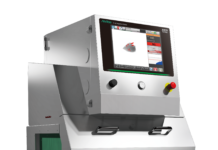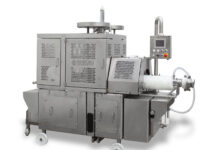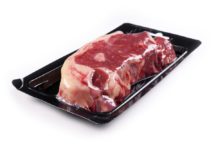 Currently there are three trends that are driving the world of meat packaging. The first is a response to the retailers’ requirement to reduce labour costs at the point of sale. The second is the increasing consumer request for high quality, fresh products that are quick and convenient. The third and last trend deals with putting safer foods out into the market. The packaging technologies that are emerging throughout the world to satisfy these requests are mainly focussed on the goal of ready to prepare, safe, pre-packaged foods[1].
Currently there are three trends that are driving the world of meat packaging. The first is a response to the retailers’ requirement to reduce labour costs at the point of sale. The second is the increasing consumer request for high quality, fresh products that are quick and convenient. The third and last trend deals with putting safer foods out into the market. The packaging technologies that are emerging throughout the world to satisfy these requests are mainly focussed on the goal of ready to prepare, safe, pre-packaged foods[1].
Packaging for case ready meats
Centralized packaging is becoming more widespread in the distribution of meat products. Fresh meats are cut and packaged before transport to the point of sale, with the primary goal of reducing the cost of labour at the retail store. Pre-packaging fresh meats is growing in the United States where in 2007 it represented 64% of the market for fresh meat as opposed to 49% in 2002. In Europe the market for case ready meats is expanding at a rate of 15% per year [3], even if in this area there are vast differences among the European countries. In the UK, almost 90% of the market is case ready meats while in Italy it only represents 10% of the market. The guidelines for new packages for case ready meat products are:
1. maximum possible product shelf life;
2. display of the product in the meat case in the best oxidation conditions so as to assure the maintenance of its red colour;
3. a complete package, bearing the label with the product price and expiry date;
4. a package that allows a good view of the meat that it contains and that remains unaltered during the storage time in the meat case.
Packaging technology for case ready meats
 The growth of pre-packaging of fresh meats is tightly linked to the possibility of maintaining the product characteristics for the longest time possible. Currently the best considered method for extending the preservation time of meats is modified atmosphere packaging (MAP). Two types of MAP are generally used, one with a high level of oxygen (typically 80% O2) or one with low levels of oxygen (generally lower than 0.05%), as opposed to the normal atmospheric levels that contain 23% oxygen.
The growth of pre-packaging of fresh meats is tightly linked to the possibility of maintaining the product characteristics for the longest time possible. Currently the best considered method for extending the preservation time of meats is modified atmosphere packaging (MAP). Two types of MAP are generally used, one with a high level of oxygen (typically 80% O2) or one with low levels of oxygen (generally lower than 0.05%), as opposed to the normal atmospheric levels that contain 23% oxygen.
• High oxygen modified atmosphere packaging
At this time, high oxygen MAP is more widely used and consists of a package that contains a modified atmosphere made up of 80% oxygen and 20% carbon dioxide(CO2). The O2 allows the longest possible maintenance of the red colour of the meat in the package, while the CO2 acts as a bacteria blocking agent [4]. The package consists of a barrier tray made of polystyrene, polypropylene or polyethylene, completed wrapped with a barrier film. The only disadvantage of this type of package is that once
the product is exposed to light at the point of sale, the shelf life, depending on the type of meat, is only 2 to 4 days from the time that the elevated levels of O2 begin to promote oxidation of the lipids.
• Low oxygen modified atmosphere packaging
This packaging system normally contains an atmosphere made up of a very low oxygen levels, less than 0.05% and starting at a 20% level of CO2. The packaging consists of a tray wrapped with film, both barrier materials. The advantage of this type of packaging is that the shelf life of the pre-packaged meat with low oxygen has a longer shelf life than that with a high oxygen MAP, ranging from 5 to 10 days depending on the type of meat. This extended life is due to the delayed oxidation process inside the package. A precise storage temperature and elevated hygienic conditions are required to guarantee the extended shelf life. In the low oxygen category of packaging, there is also MAP packaging with carbon monoxide (CO) with a mix of 20% CO2, starting at 0.4 % CO and 0.5% O2. Carbon monoxide is used to extend the shelf life of the meat to a range of 5 to 10 days. It is expected that with the recent regulations in the United States, the use of carbon monoxide packaging for fresh meats will be more wide-spread than low oxygen packaging. Even though there is a shelf-life advantage with CO, consumers generally have a negative attitude towards this gas due to its toxic hazard. This has slowed the use of CO in the packaging industry. In addition, this type of packaging has a disadvantage in that is can mask the deterioration of the meat so that the product appears to be fresh even if it has already begun to spoil. To avoid this, it is strictly mandatory to indicate the expiry date in a CO modified atmosphere package. The major advantage of this packaging is that the shelf-life is greater than that of a high oxygen package, in fact 5 to 10 days.
Packaging ready-to-eat foods
 Another important area is the technologies that minimize food preparation time for consumers. Even though it’s a fact that 75% of adults eat dinner in their own homes, the number of prepared dishes continues to decline. This has been a constant increase in the preference for prepared and frozen dishes that are more convenient and perceived furthermore as being fresher and safer. The guidelines for packaging of ready to eat foods are:
Another important area is the technologies that minimize food preparation time for consumers. Even though it’s a fact that 75% of adults eat dinner in their own homes, the number of prepared dishes continues to decline. This has been a constant increase in the preference for prepared and frozen dishes that are more convenient and perceived furthermore as being fresher and safer. The guidelines for packaging of ready to eat foods are:
1. use of containers that can be heated in the microwave and taken directly to the table;
2. development of packaging that presents the product well;
3. ease of opening the packaging;
4. relatively low costs associated with packaging materials and the value of the product.
Packaging technology for prepared meats
The recent optimization of films that can be used in the microwave is fundamentally important for the market expansion of pre-cooked meats and meats to be cooked in the package.
• Packaging for pre-cooked meats
Currently there are numerous types of packages for precooked meats, consisting of trays over-wrapped with barrier film. Usually this type of packaging contains a low oxygen modified atmosphere and must be stored at a controlled temperature and prepared in clean environment to assure an adequate product shelf life.
• Packaging for meats to cook
This type of packaging is the most innovative in the prepared foods market, driven by the development of new film materials and trays that can undergo cooking temperatures up to 90°C so that they can be heated in the oven and served directly at the table in their container.
Technology for safer foods
There are numerous useful technologies available for the reduction of harmful micro-organisms in food, resulting in increased quality and shelf-life. The methods that are considered the most efficient are the post packaging processes and the use of active anti-microbial packaging.
Processes for meat safety
The most effective processes to assure the safety of packaged meat are thermal pasteurization, high pressure processing and irradiation.
• Thermal Pasteurization
Pasteurization of the surface of the meats reduces the risk of the proliferation of harmful micro-organisms. In the majority of cases, the process consists of subjecting the product to temperatures that vary from 70 to 96°C for brief periods ranging from 30 seconds to 10 minutes. Materials that withstand the temperatures have been developed to withstand the temperatures without suffering changes to important marketing characteristics such as high transparency and good adhesion of the ink.
• High Pressure Processing (HPP)
HPP is another useful technology for the reduction of harmful micro-organisms in packaged food and it consists of the exposure of the product to very high pressure levels from 3000 to 7000 atm compared to the normal atmospheric pressure level of 1 atm. High pressure processing is brief and varies from a few seconds to a few minutes. It is used in cases where thermal pasteurization cannot be used, for example in the case of raw cured ham. Packaging materials most appropriate for this process are those that are flexible or semi-rigid so that they can withstand the deformation caused by the high pressure.
• Irradiation
 The greatest success so far with this technology has been the eliminate of Escherichia coli O157:H7 from raw beef but more generally the advantages of this technology are its capability to reduce or eliminate a great number of different type of harmful micro-organisms present in meats. The irradiation consists of the exposure of fresh, pre-package meats to gamma rays, x-rays or electromagnetic waves. The process was approved for fresh chicken more than 20 years ago and for raw red meat about ten years ago while the approval has not yet been granted for cooked meats. There are few doubts about the efficiency of irradiation but there continues to be some resistance and the number of food for which the process has been approved is still limited. Furthermore, the cost of the process is high and the available packaging materials are limited and subject to approval by the U.S. Food and Drug Administration.
The greatest success so far with this technology has been the eliminate of Escherichia coli O157:H7 from raw beef but more generally the advantages of this technology are its capability to reduce or eliminate a great number of different type of harmful micro-organisms present in meats. The irradiation consists of the exposure of fresh, pre-package meats to gamma rays, x-rays or electromagnetic waves. The process was approved for fresh chicken more than 20 years ago and for raw red meat about ten years ago while the approval has not yet been granted for cooked meats. There are few doubts about the efficiency of irradiation but there continues to be some resistance and the number of food for which the process has been approved is still limited. Furthermore, the cost of the process is high and the available packaging materials are limited and subject to approval by the U.S. Food and Drug Administration.
Packaging solutions for safe foods
Active anti-microbial packaging is an innovative technology for food preservation and in the near future will be even more wide-spread [5]. This packaging contains active substances that are slowly released onto the surface of the food, inhibiting the growth of dangerous micro-organisms and lengthening the shelf life of the product. Anti-microbial packaging materials incorporate active substances in three ways. The first is integration, which consist of mixing the active substances with the material during the production of the film. The second is encapsulation, which involves the incorporation of the active substances into the film in the form of small capsules. The third is called immobilization and is usually used to incorporate enzymes into packaging material. The three different techniques produce different types of materials and involve different release mechanisms for the active substances.
Conclusions
The trends that are driving the meat packaging sector are focussed on the pre-packaging and production of ready to eat, safe dishes. Case ready packaging will continue to expand throughout the world as the cost of labour grows. Both high and low oxygen modified atmosphere packaging are of strategic importance since they maintain the natural characteristics of the meat product. On the other hand, it can be expected that improvements in industrial technology will increasingly satisfy consumer needs for foods that are easy to prepare, safe and convenient.
References
[1] J.N. Belcher, Meat Science 74 (2006) 143-148
[2] J. Mize, J. Kelly, Cryovac Retail Wrap-up, December (2004)
[3] A. Carter, Packaging Magazine, December (2004)
[4] T. C. Jakobsen, G. Bertelsen, Meat Science 54 (2000) 49–57
[5] V. Coma, Food Science and Technology 158 (2006) 449-472



